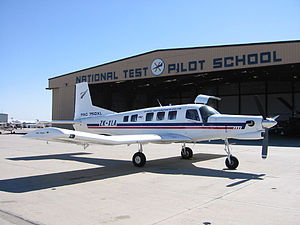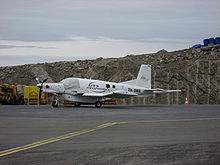- PAC P-750 XSTOL
-
P-750 XSTOL A P-750 XSTOL at the National Test Pilot School in the USA Role Utility aircraft National origin New Zealand Manufacturer Pacific Aerospace First flight 2001 Developed from PAC Cresco The PAC P-750 XSTOL, (formerly known as the PAC 750XL) is a utility aircraft of conventional all-metal low-wing monoplane design, with fixed tricycle undercarriage. Combining the engine and wings of the PAC Cresco with a new large fuselage and modified tail, all versions to date have been powered by a 750 hp (560 kW) Pratt & Whitney Canada PT6 turboprop. It is designed and manufactured in Hamilton, New Zealand by Pacific Aerospace Limited.
Contents
Design and development
The design made its maiden flight in 2001. As with the Cresco, horizontal tail surfaces presented difficulties, and these were redesigned before the type entered production. The PAC 750 received full US FAA certification in 2004.
The type was targeted initially to the narrow market of skydiving. In the parachuting role, the high-lift wings from the Cresco and relatively high power-to-weight ratio enable the PAC 750 to take a load of parachutists to 12,000 feet (3,700 m) and return to land within 15 minutes.
A wider market was subsequently sought, and examples have been sold for use in utility roles, including freight, agricultural applications, passenger operations, aerial photography and surveying. One aircraft has been extensively modified for geo-survey work, being fitted with a Magnetic anomaly detector sting tail. Proposed ski and float conversions have yet to fly. The PAC 750XL is used in South Africa by NatureLink on United Nations Humanitarian Air Services / World Food Programme contracts. While the manufacturer claims single-engine lower running costs than many other utility types, for example, the twin-engined DHC-6 Twin Otter though the type has less usable volume (large cargo panniers providing a partial solution).
Over 50 aircraft have been ordered in New Zealand by 2008, when the manufacturer stated production was increasing from 12 to 24 per year.[1]
In New Zealand there has been some media criticism of government assistance for the manufacturer following cancellation of a large order, (and the related plan to manufacture the aircraft in North America).[citation needed]
The aircraft is currently marketed as the P-750 XSTOL.
Specifications
Data from EASA Type Certificate Data Sheet
General characteristics
- Crew: 1 (pilot)
- Capacity: Pilot + 9 passengers or 17 parachutists [2]
- Length: 38 ft 10 in (11.84 m)
- Wingspan: 42 ft 0 in (12.80 m)
- Height: 13 ft 3 in (4.04 m)
- Wing area: 268 ft2 (24.88 m2)
- Empty weight: 3100 lb (1410 kg)
- Gross weight: 7500 lb (3395 kg)
- Powerplant: 1 × Pratt & Whitney PT6A-34, 750 hp (560 kW)
Performance
- Maximum speed: 196 mph (315 km/h)
- Cruise speed: 195 mph (313 km/h)
- Range: 670 miles (1078 km)
- Service ceiling: 20,000 ft (6098 m)
Operators
- Adventist Aviation Services - Papua New Guinea 1 with tail number P2 SDB[3]
- NatureLink - South Africa
See also
- Related development
- Aircraft of comparable role, configuration and era
- Quest Kodiak
- Cessna Caravan
- Pilatus PC-6
References
External links
- Manufacturers web site
- Page at utilityaircraft.com
- RCAF requirement
- European Aviation Safety Agency Type Certificate Data Sheet
Lists relating to aviation General Aircraft (manufacturers) · Aircraft engines (manufacturers) · Airlines (defunct) · Airports · Civil authorities · Museums · Registration prefixes · Rotorcraft (manufacturers) · TimelineMilitary Accidents/incidents Records Categories:- New Zealand civil utility aircraft 2000–2009
- Pacific Aerospace aircraft
- Single-engine aircraft
Wikimedia Foundation. 2010.



